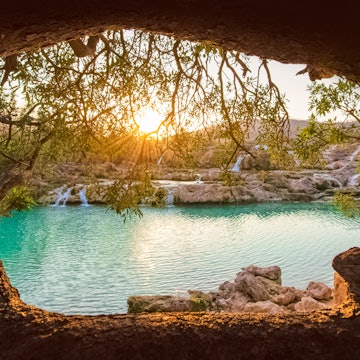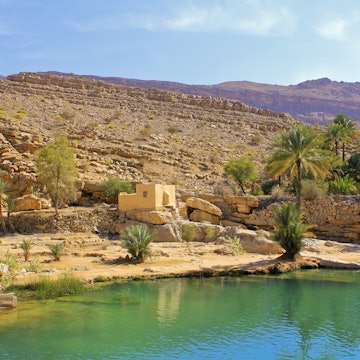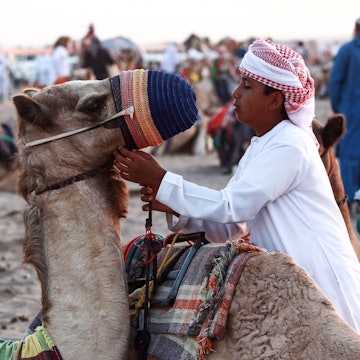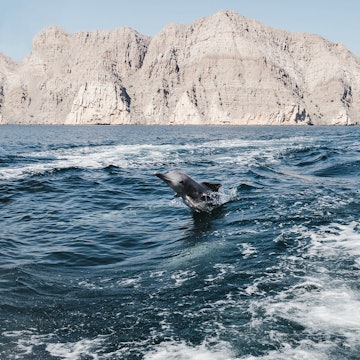

Hinged between mountains and sea, the elongated city of Muscat – where buildings are painted a uniform white by royal decree and where the regional fashion for high-rises has passed the city by – offers a haven of calm in surrounding warm waters.
Established many centuries ago around a pair of natural harbours, Oman’s capital city has traditionally kept one eye on trade across the Indian Ocean and the other on the ancient incense routes of the desert interior. Today, with its respect for heritage, its elegant mosques, conservative tastes, smart cafes and ribbons of flowering petunias, Muscat is a quiet champion of modern Arab culture.

Engage with the sea
In many ways, Muscat (meaning 'anchorage') is all about the sea, and fishing remains an important industry. Walk along Mutrah Corniche, from the new fish market to the souq, and it is easy to see how the capital is defined by its busy port, with naval vessels and cruise ships jostling with traditional wooden dhows, fishing boats and flocks of terns for space in the harbour. For the visitor, some of the capital’s best experiences revolve around the sea, such as bathing in the calm waters of the Shangri-La’s Barr al Jissah Resort & Spa, sampling grilled hamour at award-winning fish restaurant The Beach, or enjoying a sea-view sundowner at one of the city’s five-star hotels. For a gull’s eye view of the shore, head to Marina Bandar Al Rowdha; boats leave at dawn, escorted by dolphins, for the snorkelling hotspots of Bandar Khayran.

Learn about Oman’s past
Built on the revenues of oil and the benefits of good governance, Oman’s history of rags to riches over the last half-century is nothing short of a miracle. The National Museum in the heart of old Muscat charts the rise of Oman, under the leadership of the country’s highly respected leader, Sultan Qaboos, from a forgotten backwater to the dynamic, modern country that it is today. Pose for a selfie in front of the whimsical Sultan’s Palace or visit nearby Bait Al Zubair, a traditional villa housing a fine collection of Omani crafts, to get a feel for Muscat’s living history. Or for a more domestic view of the capital’s recent past, spare an hour for a little-known gem, Ghalya Museum of Modern Art on Mutrah Corniche, which offers a glimpse of Muscat life before the present sultan ushered in the Omani Renaissance in 1970.

Dine out – the local way
Anyone with a taste for local flavour will enjoy Muscat’s new trend in promoting Omani cuisine. Until recently, sampling local food was restricted to traditional halwa (a gelatinous sweetmeat) and dates with qahwa (Arabic coffee), served at official functions. At best, it meant trying shuwa (roasted lamb or goat, traditionally cooked for a day in the sand) in pan-Arab restaurants like the delightful Kargeen Cafe. While you can still sit cross-legged on a dubious communal carpet at Bin Ateeq for authentic Omani fare, there is a finer dining experience now to be had at Bait Al Luban. The menu at this atmospheric new restaurant, housed in a renovated trader’s house in Mutrah, includes a wide choice of national dishes, including the porridge-like harees.
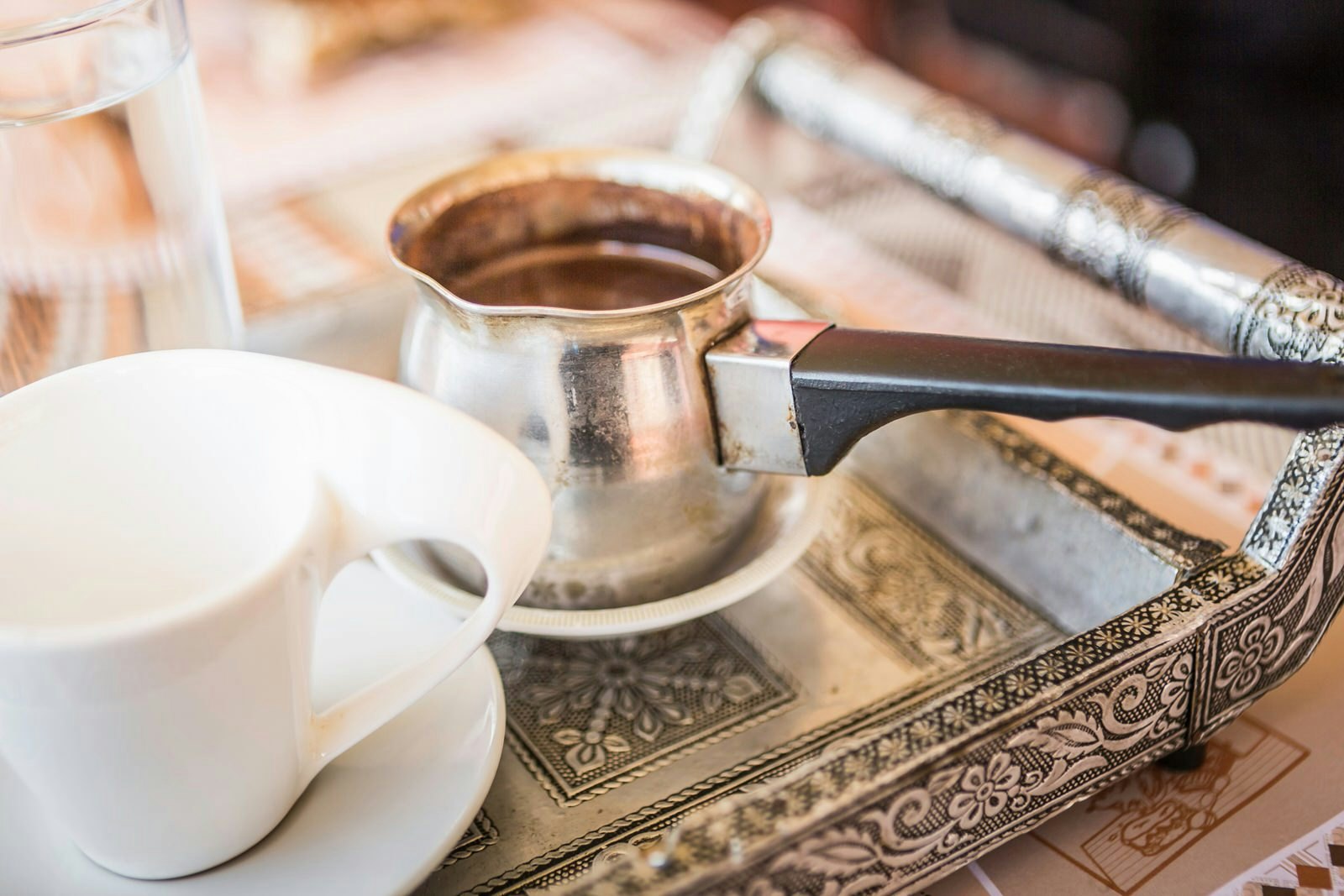
Shop for gold, frankincense and myrrh
It’s no secret that Peninsula Arabs love shopping, and the region is home to some of the world’s most extravagant malls. Muscat may not boast the retail excesses of neighbouring Dubai, but what it lacks in brand names it makes up for in character. No visit to Muscat would be complete without getting lost in the labyrinthine Mutrah Souq, where Indian traders have been plying their wares for centuries. The alleyways are perfumed with luban (frankincense), grown in the southern province of Oman and dazzle with the gold of a bride’s dowry. Elsewhere in town, especially around Qurm, look for camel-bone boxes and chocolate-covered dates, carpets from Persia and rugs from Azerbaijan, beads of semi-precious stones and pashminas that fit through a wedding ring. Less easy to find, except in the Omani Heritage Gallery in Qurm, are local crafts such as camel-leather baskets, earthenware pots and goat-hair rugs.

Add an extra day
An excellent road network is one of the many blessings of the Omani Renaissance, so with an extra day, it is easy to take a day trip from the capital to explore the legendary ‘interior’. One of the best excursions covers a loop around the Batinah Plain, beginning in the castle town of Nakhal. Visit the fort, watch brilliant-winged Indian rollers dart through the date plantations, and pause by the hot springs. Continue along the base of the imposing Hajar Mountains to the former capital of Rustaq, crowned by another of Oman’s many forts. Return to Muscat via Sawadi, famed for a beach carpeted in pink top shells and punctuated by islands accessible on foot at low tide.
Top Tips
Unless you view travel as an extreme sport, avoid the intensely hot and humid summer (May to September inclusive). Even the locals abandon Muscat at this time as temperatures soar above the bearable.
While you’ll see the odd pair of shorts and a strappy top in the malls and along the beach, Omanis prefer visitors to respect the local culture and cover shoulders and knees.
Taxis remain the easiest way to move about the city but there is also a modern bus service, called Mowasalat, which links the main suburbs.






